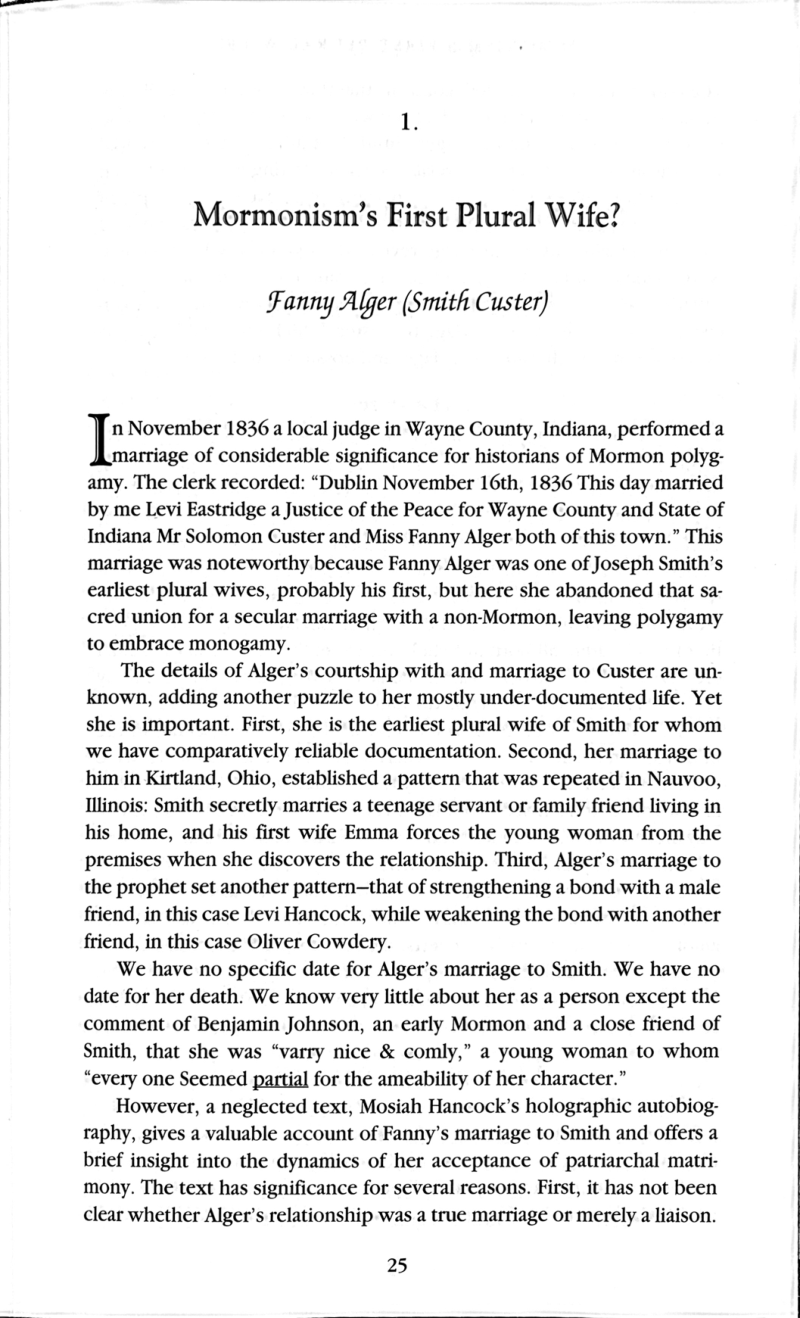Compton writes on Joseph's relationship with Alger; argues it was the first plural marriage.
- Type
- Book
- Source
- Todd M. Compton LDSDisaffected
- Hearsay
- Secondary
- Reference
Todd Compton, In Sacred Lonliness: The Plural Wives of Joseph Smith (Salt Lake City, UT: Signature Books, 1997), 25–26, 42
- Scribe/Publisher
- Signature Books
- Audience
- Reading Public
- Transcription
The details of Alger's courtship with and marriage to Custer are unknown, adding another puzzle to her mostly under-documented life. Yet she is important. First, she is the earliest plural wife of Smith for whom we have comparatively reliable documentation. Second, her marriage to him in Kirtland, Ohio, established a pattern that was repeated in Nauvoo, Illinois: Smith secretly marries a teenage servant or family friend living in his home, and his first wife Emma forces the young woman from the premises when she discovers the relationship. Third, Alger's marriage to the prophet set another pattern-that of strengthening a bond with a male friend, in this case Levi Hancock, while weakening the bond with another friend, in this case Oliver Cowdery.
We have no specific date for Alger's marriage to Smith. We have no date for her death. We know very little about her as a person except the comment of Benjamin Johnson, an early Mormon and a close friend of Smith, that she was "varry nice & comly," a young woman to whom "every one Seemed partial for the ameability of her character."
However, a neglected text, Mosiah Hancock's holographic autobiography, gives a valuable account of Fanny's marriage to Smith and offers a brief insight into the dynamics of her acceptance of patriarchal matrimony. The text has significance for several reasons. First, it has not been clear whether Alger's relationship was a true marriage or merely a liaison.
The Hancock text, if accepted, confirms that there was an actual, if nontraditional, wedding ceremony. It also documnents a pattern that became important in later plural marriages: Smith first approaches a potential wife through one of her male relatives, thus creating a bond between Smith and the relative. The Hancock narrative is also a good example of the anthropologically interesting phenomenon known as "exchange of women." Finally, Alger's marriage reveals the extent to which women were involved in negotiating and deciding plural marriages, as the consultation with her mother and Fanny herself will show. She also exercised choice in her later marriage to Custer, which involved her rejection of Joseph Smith, plural marriage, and possibly Mormonism.
. . .
Approximately a year later, in early 1833, Joseph Smith, Jr., was joined to Fanny Alger in perhaps the first plural marriage in Mormon history. A number of sources, both contemporary and recollected, provide evidence that polygamy was developed and practiced in the New York and Kirtland period.
. . .
This still leaves unanswered the question of why Fanny agreed to the marriage. Mosiah says that Joseph "loved' her. One wonders how such a relation developed. Had he and she spent time alone together? Did Fanny in fact reciprocate Smith's feelings and choose him freely, or did she accept his proposal because, like Zina Huntington in Nauvoo, she regarded him as a prophet and feared to disobey divine revelation?
Historical documents also give no evidence as to what might have happened if Fanny had rejected the proposal. Would Joseph, Levi, Samuel, and Clarissa have pressured her to accept the marriage, as Helen Mar Kimball and Lucy Walker were pressured in Nauvoo? Would Joseph have forbidden Levi's and Clarissa's marriage if the uncle had not brought his niece back? Though Fanny accepted Smith's proposal in 1833, in 1836 she rejected him, the physical community of Mormonism, the geographical Zion that was a central tenet of the nineteenth-century faith, even though the choice involved separation from her family. One can only ask questions: Had she had become disillusioned with Smith's doctrine or practice of polygamy? If she had been in love with Joseph, was she now? How did the experience of being expelled from the Smith home, and possibly of being considered an unwed mother, affect her emotionally? She made a choice, even though her motives remain obscure and social structures worked against her complete freedom. Modern Latter-daySaints who are uncomfortable with polygamy may debate whether Fanny's choice was right or wrong.
- Citations in Mormonr Qnas
The B. H. Roberts Foundation is not owned by, operated by, or affiliated with the Church of Jesus Christ of Latter-day Saints.

